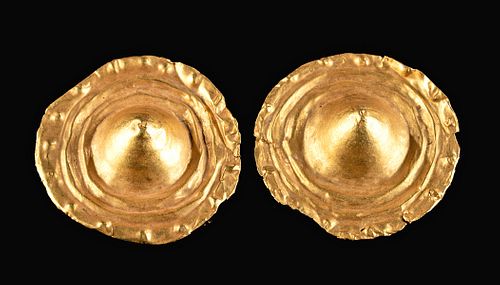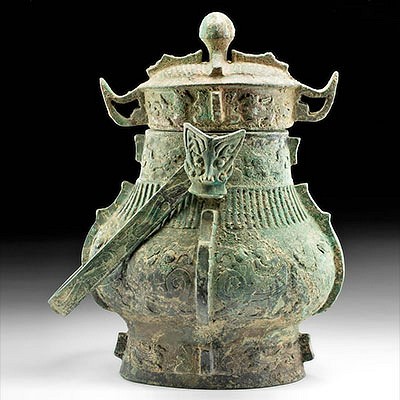Roman 20K+ Gold Dome Ornaments Matching Pair
Lot 16a
About Seller
Artemis Fine Arts
686 S Taylor Ave, Ste 106
Louisville, CO 80027
United States
Selling antiquities, ancient and ethnographic art online since 1993, Artemis Gallery specializes in Classical Antiquities (Egyptian, Greek, Roman, Near Eastern), Asian, Pre-Columbian, African / Tribal / Oceanographic art. Our extensive inventory includes pottery, stone, metal, wood, glass and textil...Read more
Categories
Estimate:
$800 - $1,200
Absentee vs Live bid
Two ways to bid:
- Leave a max absentee bid and the platform will bid on your behalf up to your maximum bid during the live auction.
- Bid live during the auction and your bids will be submitted real-time to the auctioneer.
Bid Increments
| Price | Bid Increment |
|---|---|
| $0 | $25 |
| $300 | $50 |
| $1,000 | $100 |
| $2,000 | $250 |
| $5,000 | $500 |
| $10,000 | $1,000 |
| $20,000 | $2,500 |
| $50,000 | $5,000 |
| $100,000 | $10,000 |
| $200,000 | $20,000 |
About Auction
By Artemis Fine Arts
Jul 1, 2020
Set Reminder
2020-07-01 10:00:00
2020-07-01 10:00:00
America/New_York
Bidsquare
Bidsquare : Ancient | Near-Eastern | Asian Art
https://www.bidsquare.com/auctions/artemis-gallery/ancient-near-eastern-asian-art-5276
Ancient art from Egypt, Greece, Italy and the Near East, as well as Asian, Fossils, Pre-Columbian, Native American, African / Tribal / Oceanic, Spanish Colonial, Russian Icons, Fine art, much more! Artemis Fine Arts info@artemisfinearts.com
Ancient art from Egypt, Greece, Italy and the Near East, as well as Asian, Fossils, Pre-Columbian, Native American, African / Tribal / Oceanic, Spanish Colonial, Russian Icons, Fine art, much more! Artemis Fine Arts info@artemisfinearts.com
- Lot Description
Late Roman, Imperial Period, 3rd century CE. An elegant pair of matching Roman 86% gold (equivalent to 20K+) domed ornaments with high central domes encircled by concentric rings that are delineated via repousse as well as traces of a border of petite bosses. The women of the Roman Empire donned a wide assortment of jewelry. We know this to be true, because elite Roman women were laid to rest in sarcophagi painted with encaustic funerary portraits that depicted the deceased as youthful beauties dressed in refined clothing and bejeweled in elaborate necklaces and earrings. In addition, the sculpted stone portraits of the caravan city of Palmyra in Syria show the deceased donning jewelry, no doubt indicating their wealth and high social status for all eternity. Size of each (both are relatively similar): 1.25" W (3.2 cm); quality of gold: 86% (equivalent to 20K+); total weight: 4.2 grams.
While it is possible that these ornaments were simply intended to be decorative and abstract in nature, it is also possible that they were intended to represent an actual architectural dome, an innovation made possible by the Roman's invention of concrete, or a celestial orb such as the sun or the moon. The Romans were excellent engineers and monumental domes created for edifices like the famous Pantheon began to eclipse traditional post and lintel architecture by the 1st century BCE in ancient Rome. As for the Romans' worship of celestial bodies such as the sun and the moon, much can be said. The Roman god Sol (Greek Helios) was believed to ride a golden chariot that carried the sun across the skies every day from East to West. In addition to appearing on beautiful painted vases riding his golden chariot in the background of imagery narrating the Hercules (Herakles) story, gracing the faces of coins of Rhodes - his patron city, as well as the east pediment of the Parthenon where he emerges from the ocean in his chariot, Helios is perhaps most famously the subject of the Colossus of Rhodes, a monumental bronze statue regarded as one of the Seven Wonders of the Ancient World. Luna (Selene to the Greeks), goddess of the moon, also drove her steeds across the heavens.
Provenance: ex-Frances Artuner collection, Belgium, collected in the 1960s
All items legal to buy/sell under U.S. Statute covering cultural patrimony Code 2600, CHAPTER 14, and are guaranteed to be as described or your money back.
A Certificate of Authenticity will accompany all winning bids.
We ship worldwide and handle all shipping in-house for your convenience.
#155514Both items have slight bending to overall forms, with minor abrasions, and petite indentations to tips of center cones, otherwise intact and excellent. Nice patina throughout.Condition
- Shipping Info
-
All shipping is handled in-house for your convenience. Your invoice from Artemis Gallery will include shipping calculation instructions. If in doubt, please inquire BEFORE bidding for estimated shipping costs for individual items.
-
- Buyer's Premium



 EUR
EUR CAD
CAD AUD
AUD GBP
GBP MXN
MXN HKD
HKD CNY
CNY MYR
MYR SEK
SEK SGD
SGD CHF
CHF THB
THB













